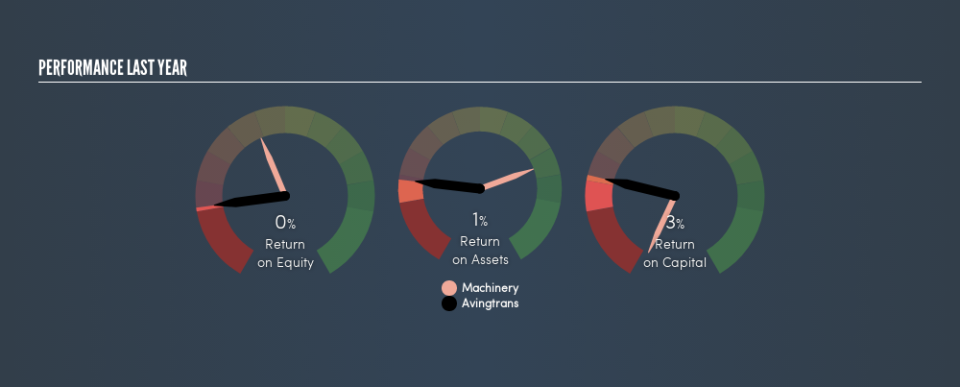Avingtrans plc (LON:AVG) Might Not Be A Great Investment

Today we'll look at Avingtrans plc (LON:AVG) and reflect on its potential as an investment. Specifically, we're going to calculate its Return On Capital Employed (ROCE), in the hopes of getting some insight into the business.
First up, we'll look at what ROCE is and how we calculate it. Second, we'll look at its ROCE compared to similar companies. Finally, we'll look at how its current liabilities affect its ROCE.
Return On Capital Employed (ROCE): What is it?
ROCE measures the 'return' (pre-tax profit) a company generates from capital employed in its business. All else being equal, a better business will have a higher ROCE. Ultimately, it is a useful but imperfect metric. Renowned investment researcher Michael Mauboussin has suggested that a high ROCE can indicate that 'one dollar invested in the company generates value of more than one dollar'.
How Do You Calculate Return On Capital Employed?
The formula for calculating the return on capital employed is:
Return on Capital Employed = Earnings Before Interest and Tax (EBIT) ÷ (Total Assets - Current Liabilities)
Or for Avingtrans:
0.028 = UK£2.2m ÷ (UK£117m - UK£38m) (Based on the trailing twelve months to November 2018.)
Therefore, Avingtrans has an ROCE of 2.8%.
Want to participate in a short research study? Help shape the future of investing tools and you could win a $250 gift card!
View our latest analysis for Avingtrans
Is Avingtrans's ROCE Good?
ROCE is commonly used for comparing the performance of similar businesses. We can see Avingtrans's ROCE is meaningfully below the Machinery industry average of 13%. This performance is not ideal, as it suggests the company may not be deploying its capital as effectively as some competitors. Putting aside Avingtrans's performance relative to its industry, its ROCE in absolute terms is poor - considering the risk of owning stocks compared to government bonds. There are potentially more appealing investments elsewhere.
Avingtrans has an ROCE of 2.8%, but it didn't have an ROCE 3 years ago, since it was unprofitable. That suggests the business has returned to profitability.
Remember that this metric is backwards looking - it shows what has happened in the past, and does not accurately predict the future. ROCE can be deceptive for cyclical businesses, as returns can look incredible in boom times, and terribly low in downturns. This is because ROCE only looks at one year, instead of considering returns across a whole cycle. What happens in the future is pretty important for investors, so we have prepared a free report on analyst forecasts for Avingtrans.
Do Avingtrans's Current Liabilities Skew Its ROCE?
Current liabilities include invoices, such as supplier payments, short-term debt, or a tax bill, that need to be paid within 12 months. The ROCE equation subtracts current liabilities from capital employed, so a company with a lot of current liabilities appears to have less capital employed, and a higher ROCE than otherwise. To counteract this, we check if a company has high current liabilities, relative to its total assets.
Avingtrans has total assets of UK£117m and current liabilities of UK£38m. Therefore its current liabilities are equivalent to approximately 33% of its total assets. With a medium level of current liabilities boosting the ROCE a little, Avingtrans's low ROCE is unappealing.
Our Take On Avingtrans's ROCE
This company may not be the most attractive investment prospect. Of course, you might also be able to find a better stock than Avingtrans. So you may wish to see this free collection of other companies that have grown earnings strongly.
For those who like to find winning investments this free list of growing companies with recent insider purchasing, could be just the ticket.
We aim to bring you long-term focused research analysis driven by fundamental data. Note that our analysis may not factor in the latest price-sensitive company announcements or qualitative material.
If you spot an error that warrants correction, please contact the editor at editorial-team@simplywallst.com. This article by Simply Wall St is general in nature. It does not constitute a recommendation to buy or sell any stock, and does not take account of your objectives, or your financial situation. Simply Wall St has no position in the stocks mentioned. Thank you for reading.

